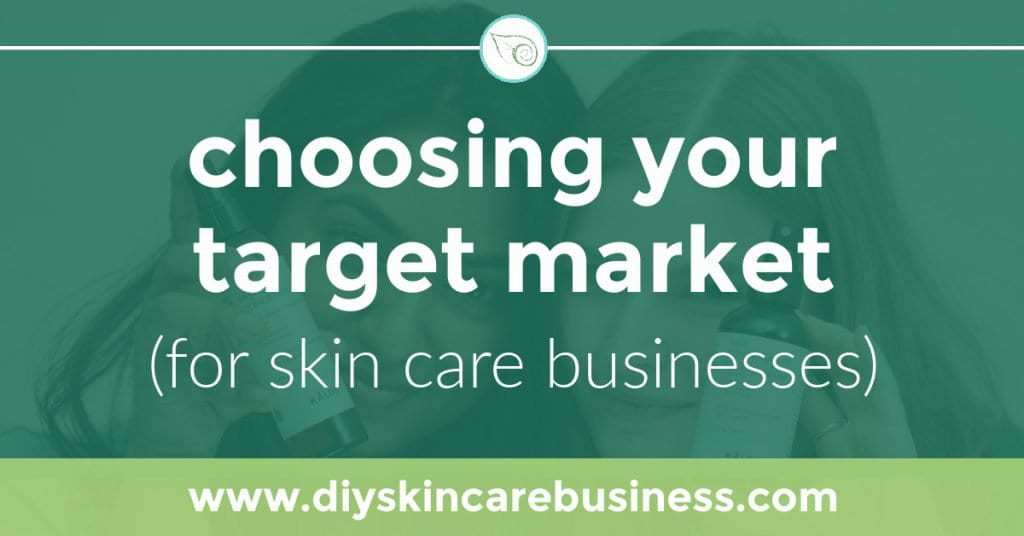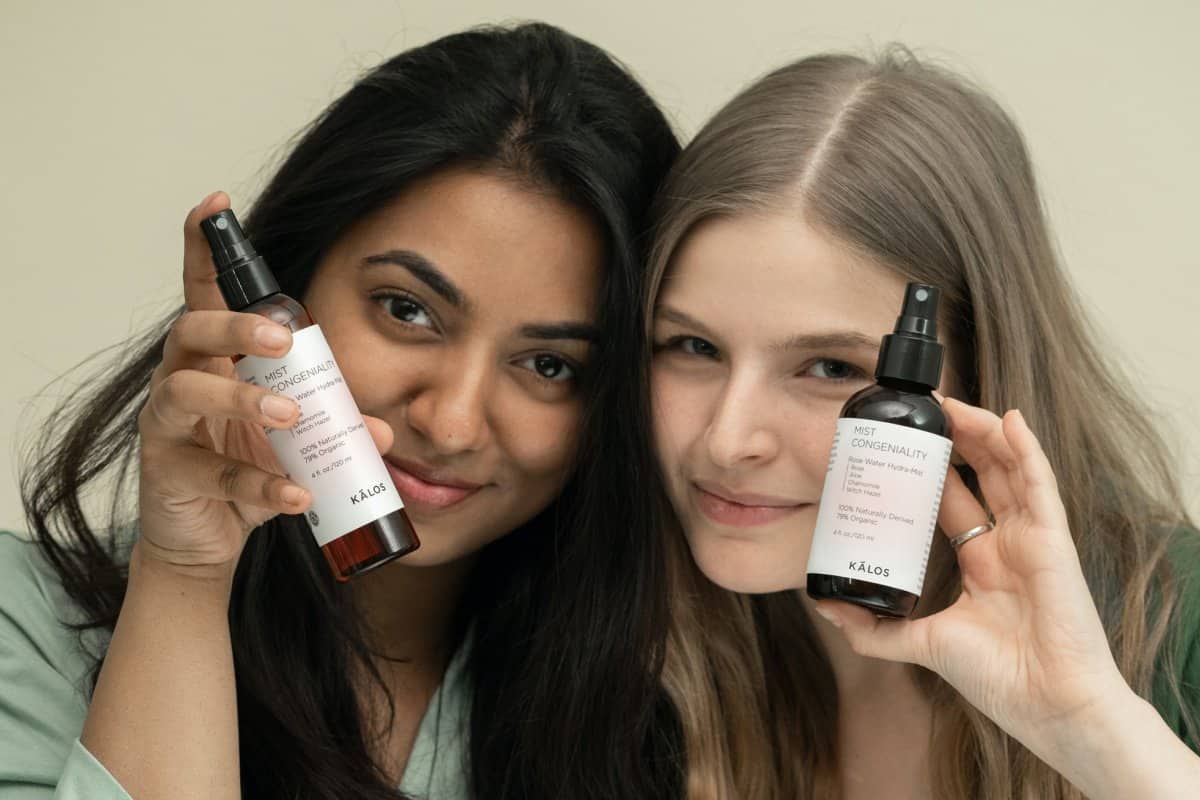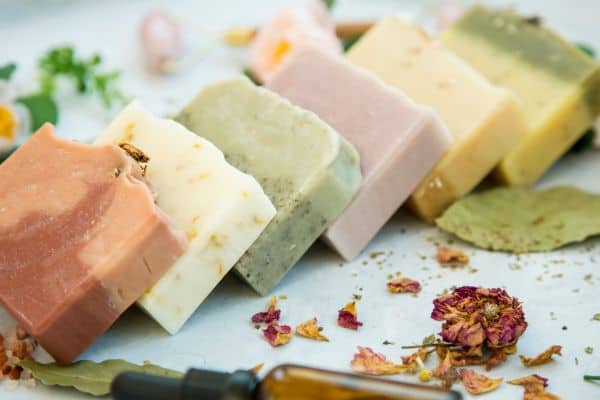Deciding on your handmade skin care target market is the first public-facing decision you will make for your business.
It is assumed that you have already considered your business mission, the big ‘WHY’ behind selling your skin care products in the first place.
Use that fresh excitement to develop your ideal target market intentionally so that your customers will turn into proud advocates for everything you do.
Yes.
YOU get to DECIDE who to sell to!
As a small business owner, you have the freedom to be SUPER detailed about what you create and what kind of customer base is perfect for your brand.
But it’s more than a freedom.
Having a zeroed-in target market is a requirement to be successful in the handmade industry.
If you try to sell to everyone, you will sell to no one.
You’re not going to sell a $10 lip balm in sustainable packaging to a ramen-noodle-eating college student.
A well-off environmentalist is not going to be enticed to purchase a lip balm that has a bright cartoon-y font and packaged in a plastic tube.
By thinking about tiny details (that all add up to something not so tiny), your audience will say,
“Holy cow, it seems like this (enter amazing skin care product here) was literally made with me in mind!”
…because it WILL be.

This post may contain affiliate links, meaning I get a commission if you decide to make a purchase through my links (at no cost to you). Please read the disclosure for more information.
If you have not written a mission statement for your handmade skincare business, do that before proceeding.
Handmade Skin Care Target Market for Organic Products
So that we’re all starting on the same page here, our definition of a target market is, “A particular group of consumers at which a product or service is aimed.”
We’re going to zero in on the word ‘PARTICULAR’.
There are SO many particular groups to choose from, especially if you are on the path to creating an organic skin care line.
The “global organic skin care market is expected to rise with a CAGR of 10%” by 2024.
- North America is the leading market for revenue share.
- Asia Pacific will be the fastest-growing market region.
- Females will be the top gender for industry growth.
- There will be more demand for multi-use items to solve skin care issues.
Is this enough information for us to effectively brand our skin care businesses?
Heck no.
We are not L’Oréal®.
We will get found as a small, handmade business by diving one million feet deeper.
As an example, in the United States, the top three markets for natural skin care sales growth are young professionals, new mothers, and women 65+…and each of THOSE areas is just the tip of the target market iceberg.



Handmade Skin Care Marketing Strategy
This article is about choosing your handmade skin care target market, which will have a direct impact on your marketing strategy.
It is essential that you understand WHY taking the deep dive into understanding your target customer is so important to the foundation of your handmade business.
A solid marketing strategy requires that every single detail of your business be an intentional decision that is based on the needs and likes of your target market.
For handmade skin care businesses, this means:
It is IMPOSSIBLE to do any of this WELL if you don’t understand every nook and cranny of who you are selling to.
Even if you were immediately drawn to one of the top three customer growth areas above, there is still A LOT to unpack before moving on in your business planning.
BY PUTTING IN YOUR TARGET MARKET RESEARCH, YOU WILL END UP WITH CUSTOMERS THAT WILL:
- Comment on your social media posts
- Share their experiences via reviews on their own social accounts
- Tag other potential customers in your advertising (“@marymaryquitecontrary, this is the serum I was telling you about!”)
- Restock your products when they’re running out
- Give your products during gifting occasions
Without further ado, let’s build a solid foundation for that business of yours!
UNDERSTANDING YOUR TARGET MARKET
To brand yourself successfully, you need to identify your:
- Demographics (general facts about your target market)
- Psychographics (what those individuals see as valuable)
- Secret Sauce (zeroed-in details about time spent)
- Customer Avatar (combining this information together to better relate)
Step 1: Demographics
The definition of demographics is ‘the statistical characteristics of human populations used especially to identify markets’, and this includes age, gender, economic status, geographic location, marital status, education, and employment.
Age
Choose ONE age to market to. That helps you get incredibly specific about the exact life stage and experiences that your customer is going through.
To explain more fully, check out this statistic: “Almost 70% of US consumers between the ages of 18 and 29 state that they preferred natural and organic skin care products.”
In this example, eleven years might sound like a small range, but think about the HUGE difference in lifestyles of those ages.
- Most eighteen-year-olds in the United States have just graduated from high school.
- Twenty-nine-year-olds could have graduated from college, could be well into a career, could be married, and could have multiple children.
You can’t market effectively to both of those possibilities simultaneously.
Again, choose just ONE age for your focus.
Gender
Females are the top gender for industry growth (though worth noting that there is an increased demand in the male population for facial care and sun care products).
Whether you are marketing towards women, men, or other identities, stick to ONE.
If you try to cater to all identities, you will cater to none.
Economic Status
Economic status (VERY broadly meaning ‘how much money you make’) is categorized into five classes: upper, upper-middle, middle, working and lower.
This factor alone will be HUGE in your skin care marketing. It will lead every decision you make.
If your handmade skin care target market is in the middle or working class, you’ll have more success if you purchase items that are agreeable to those on a budget: plastic packaging, product labels printed at home, reused shipping boxes, and non-organic ingredients.
If your target market is in the upper-middle class, you will have no problem charging a higher price tag for products that have branding details where cost isn’t a factor: sustainable packaging, professionally printed labels, a branded unboxing experience, and 100% organic ingredients.
Geographic Location
Another huge ‘detail’ to consider. Where in the world is your customer?
Skin care trends vary widely across the globe.
In Korean skin care, the term ‘glass skin’ is what everyone is talking about. There are entire websites strictly dedicated to all things K-beauty.
In the United States, eco-beauty brands and CBD skin care are all the rage.
But even within the U.S., there are differences in trends and needs: Californians (West Coast) have to dish out more money for products with SPF all year round, whereas New Yorkers (East Coast) have to deal with dry skin due to windy, cold weather for part of the year.
It’s a MUST to know where your audience lives to create products they’ll actually find useful.
Marital Status
In terms of branding, this demographic category doesn’t affect skin care sales one way or the other.
As you will see in our exercise below, it is a detail to consider when coming up with your ‘ideal customer’ just to really complete their identity in your head. But certainly not a requirement.
Education
The educational status of your skin care target market could have a strong hand in your branding.
Educational status, meaning the level of schooling completed (less than a high school diploma, high school graduate, some college/no degree, Associate degree, Bachelor’s degree, Master’s degree, Professional degree, Doctoral degree) has a direct tie to income in the United States.
As discussed in the economic status section, this will affect what types of products and packaging you offer to your customers.
Additionally, educational status may determine how you talk to your customers.
The vocabulary and tone that you use in your product descriptions and marketing campaigns could vary based on the educational background of your target audience.
Employment
For most employed individuals, what you do for income takes up the majority of the day.
The type of skin care products used will change based on how much time your customer has and what they are doing as they work.
On the other hand, if not employed, this speaks volumes as well.
Is your customer a stay-at-home mom who has an unpredictable sleep schedule? Or a retired individual with lots of time on her hands to research possibilities?
Employment details have a HUGE impact on what products you will create for your chosen target market.
Step 2: Psychographics
The definition of psychographics is ‘the study and classification of people according to their attitudes, aspirations, and other psychological criteria, especially in market research.’ This includes religious affiliation, political affiliation, hobbies, and lifestyle.
Religious & Political Affiliation
The three subjects considered taboo to discuss: Sex, Religion, and Politics.
Risky waters for entrepreneurs.
It is up to you how you handle your own business.
People feel very strongly about their religious and political beliefs – if you decide to incorporate either of these subjects in your business branding, realize you will win some customers and alienate others.
That being said, knowing what your ideal customer believes will help to guide your product list, how you discuss the use of your products, as well as helping to direct any sort of marketing campaigns you develop for your brand (what holidays to recognize on social media, promotions, etc).
Hobbies & Lifestyle
Hobbies and lifestyle choices are much easier topics to approach in branding, and quite a bit can be deduced based on the other details from our handmade skin care target market research.
Natural skin care is the perfect industry example of how you can assume OTHER things about your customer’s life.
If someone is conscious of what they put on their skin, you can safely bet that they are also conscious of what they consume.
Most individuals who have more intentional diets take care of their bodies in other ways, such as regular exercise and wellness habits.
Following this train of thought makes it easy to add details to your branding and marketing details, such as creating the perfect SPF lip balm for a hiking trip or a great aromatherapy roller to use during yoga practice.
Hobbies and lifestyle are REALLY FUN details to consider when creating your specific target market – get creative!
Step 3: The Secret Sauce
A customer profile is a description of a set of customers that includes demographic and psychographic characteristics…but taking it ONE STEP FURTHER is really where the connection happens.
These are the details that will make your customer stop and say, “Wait…how does this company know everything about me???”
Ideas include:
- Favorite TV shows
- Favorite things to read
- Voice/slang/terminology
- Fashion choices
Before you tell me that I’m getting WAY too deep, hear me out.
All of these details created an unconscious connection and memory between you and the advertiser…those details made you stop (they were no accident either).
Next time, it might make you stop and PURCHASE.
These subtle details are incredibly POWERFUL and create CONVERSIONS over time.
Step 4: Creating Your Customer Avatar
A customer avatar is a PERSON in mind (either made up or real) so that you can flesh out these super-specific details more easily by actually visualizing a human being instead of a list of facts.
Using all of the information discussed above, give this person real needs and desires that will lead them to your business.
- Give your person a NAME.
- What is this person actually doing as they stumble upon your line?
- Where are they sitting?
- What has their day been like?
- How did they find you and your products?
- Why are they interested in your line?
- Why are they interested in your business right now specifically?
- What problem will you be solving for them?
The point is to have an EXACT PERSON that you can visualize speaking to as you build a brand they will love.
Handmade Skin Care Target Market Example
In the following example, all of the information that was discussed above has been put together to create my (pretend) customer avatar that is instantly drawn to a natural product line for new moms:
Step 1: Demographics (Statistical Characteristics)
- Age: 32
- Gender: Female
- Economic Status: Middle Class
- Geographic Location: Midwest (United States)
- Marital Status: Married
- Education: Bachelor of Science in Education (K-12 Visual Arts)
- Current Employment: Stay-at-Home Mom
Step 2: Psychographics (Attitudes and Aspirations)
- Religious Affiliation: Buddhist
- Political Affiliation: Democrat
- Hobbies: Hiking, yoga, art
- Lifestyle: New mommy life. Waking up throughout the night to nurse her baby, trying to get laundry done during nap times, adjusting to not getting as much self-care time as she used to. Social life is texting and the occasional FaceTime call with family. Date nights (if you can even call them that?) are at home after baby is in bed, but both her and her husband are still asleep by 9p – this new life is so full of joy, but whoa. Exhausting.
Step 3: Secret Sauce (Hobbies and Personality)
- Favorite TV Shows: Documentaries, political dramas
- Favorite reading material: Anything on Pinterest that is a new mommy ‘how to’ (meal planning, making baby food, managing time, etc.)
- Voice: Casual and fun, yet not so up-to-date on what ‘the cool kids are saying these days’
- Fashion: Pajama pants and tanks all day every day. If enough energy to run errands, she’ll step it up with yoga pants and a sports bra.
- Technology: Lives for her Apple Watch. Who has hands to carry a phone when there’s a baby to hold and laundry to fold?
Step 4: Customer Avatar (Turn These Details into a Person)
Katy has just handed the baby off to her husband who walked in the door from work a whole five seconds ago. Dinner is on the stove, but she just needs 10 (can we make it 20???) minutes to herself.
Her skin is beyond dry since giving birth – it’s so hard to keep up with hydration when nursing. On top of that, the dark circles under her eyes from strange sleep patterns are making her look like a zombie.
She takes the rare chance to hop on the office computer (it’s quiet…hallelujah!) to search for some organic skin care options. She gave birth to her little girl naturally, and there’s no way she’s putting chemicals on her body for her little girl to absorb or ingest.
Katy is over the MOON to find your shop because you don’t just offer facial skin care, but also something to help the other current body ‘things’ – stretch marks, sore nipples, and even an organic lip tint that will help her feel a little more ‘put together’…if the occasion presents itself.
See how all of these details can come together as a story to make the PERFECT solution for your ideal customer???
How to Apply This Information to YOUR Skin Care Business
So the BIG question…how do you decide which target market to choose for YOUR handmade skin care business?
Many people try to make themselves their own market because it’s the most comfortable.
However, when you choose yourself as your customer avatar, it’s easy to forget details and assume understanding.
Doing full-blown research on someone who is different from you will help you create a complete profile.
I recommend going through all of the above-mentioned information (demographics, psychographics, secret sauce, and full-blown customer avatar description) to create a range of THREE different customer types.
There is no right or wrong here, have fun with the process!
Obviously, you want the information that you come up with to ‘make sense’ together, but give your three customers very identifiable personalities that will help you make clear branding decisions later.
Making Your Final Decision
After you complete all three of your own customer profiles and create an avatar for each, you will need to decide which identity you will focus on for your business.
Choose the one that checks all the points below (on every platform…your website, social media, directly in one-on-one communication), over the stretch of time.
- Which customer can you speak and write to most effectively?
- Which customer has enough needs and desires to build an entire product line around?
- Which customer most strongly supports your business goals and mission statement?
- Which customer will you be able to ‘speak to’ long term (so that you’re not having to rebrand one year from now)?
If you followed that exercise through and created a fully fleshed-out customer avatar, CONGRATULATIONS on taking your first step towards a successful, branded business – this foundational work is going to pay off in so many ways as you flesh out your skin care line.
Deciding on your handmade skin care target market is just one step to check off your list when either LAUNCHING for the first time or RE-BRANDING your line.
Check out the resources below to help you continue building out your dream skin care business!
Grow Your Skin Care Business!
Browse through the resources below to boost your handmade business visibility and profitability!








